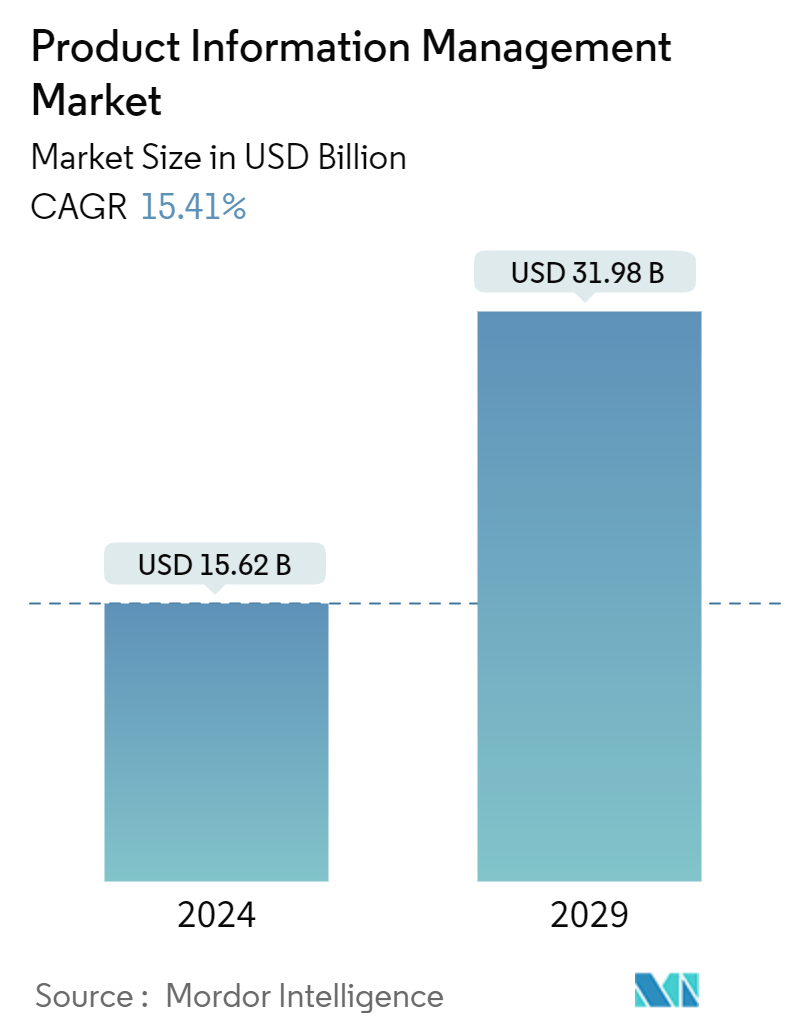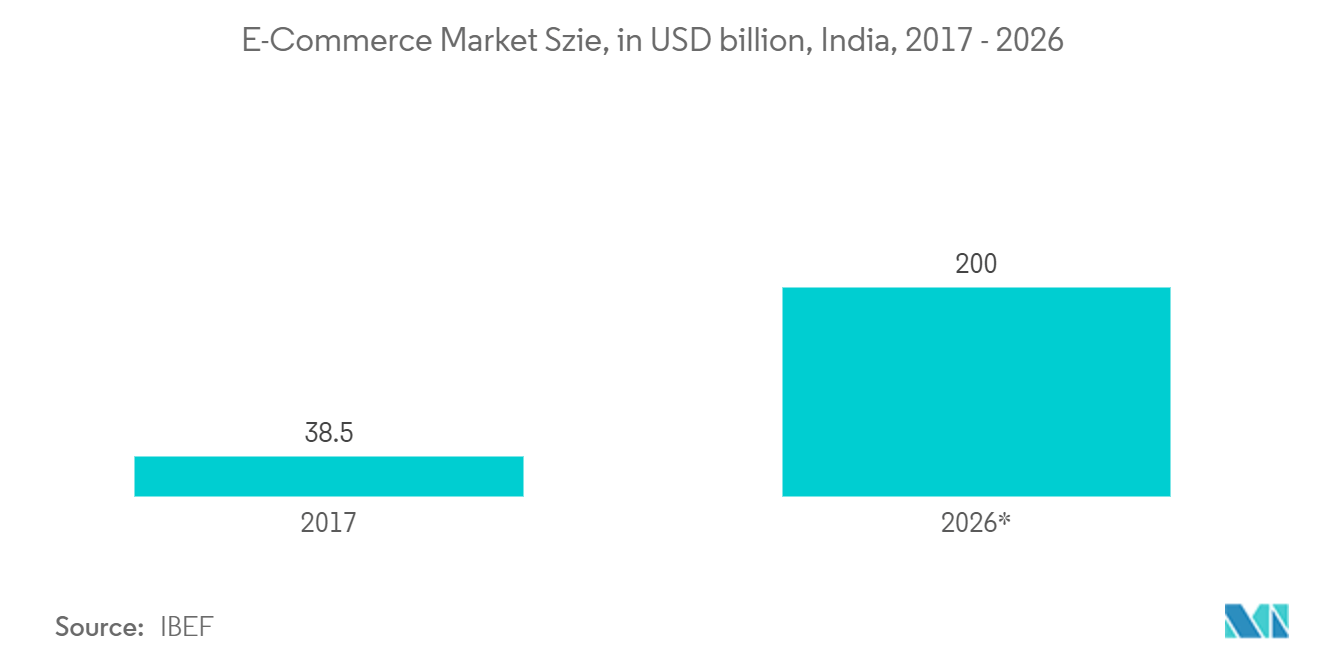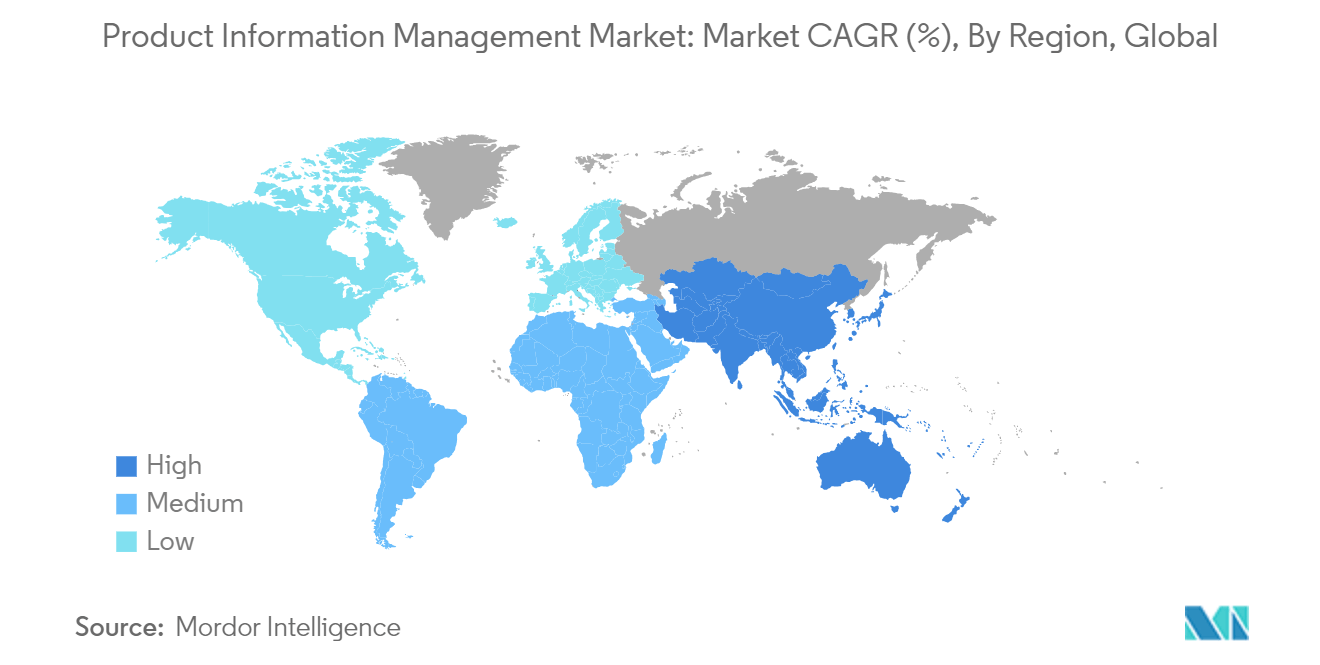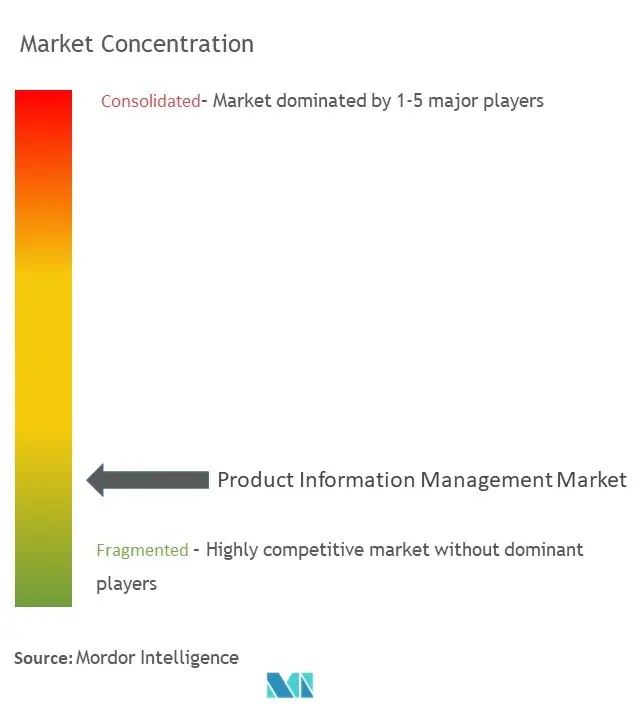Product Information Management Market Size

| Study Period | 2019 - 2029 |
| Market Size (2024) | USD 15.62 Billion |
| Market Size (2029) | USD 31.98 Billion |
| CAGR (2024 - 2029) | 15.41 % |
| Fastest Growing Market | Asia Pacific |
| Largest Market | North America |
Major Players
*Disclaimer: Major Players sorted in no particular order |
Need a report that reflects how COVID-19 has impacted this market and its growth?
Product Information Management Market Analysis
The Product Information Management Market size is estimated at USD 15.62 billion in 2024, and is expected to reach USD 31.98 billion by 2029, growing at a CAGR of 15.41% during the forecast period (2024-2029).
Product information management (PIM) solutions unify and manage a business' product information to secure a single accurate view of product data. PIM offers a centralized platform to manage data on a business's products and services cost-effectively.
- The management of products in a central space increases the use of solutions by retailers, manufacturers, and wholesalers. PIM contributes to maintaining the consistency and quality of product data obtained from a variety of sources and consolidating them into one common database. By streamlining internal and external marketing processes, the growing adoption of PIM software in various vertical industries delivers improved customer satisfaction and omnichannel experiences.
- With the massive growth in data generation, data and information have become the backbone of organizations and businesses. In addition to storing and transferring product data, PIMs bolster overall data quality, encourage data audits, and can improve the accuracy of the product information. Data quality and consistency are naturally improved by reducing the need to manage redundant information in multiple systems. Government regulations are instrumental in augmenting the PIM market, particularly across healthcare and online business solutions, owing to the need for a centralized system to hold the data and processes and manage the launch and update of products.
- With the impact of the COVID-19 pandemic, e-commerce has significantly grown, indicating growth and adoption of PIM solutions. A continuously growing number of internet sales generates huge demand for adopting an eCommerce system. This e-commerce system offers Enterprise Resource Planning systems, Supply Chain Management Systems, and Customer Relationship Management Systems to meet customers' growing demand for real-time product information. Companies with a wide range of products have sophisticated categorizations in their product catalogs.
- This complex nature of digital commerce engages many companies to streamline product information creation, maintenance, and publication to downstream channels. PIM makes it easy for many channels and media to disseminate information. Thus, various end users are adopting this software to manage a large amount of product content. Therefore, the demand for PIM software has shown a considerable rise because of the growing complexity of data management resulting from electronic commerce.
- Data breaches have the potential to undermine the trust and reputation of businesses, resulting in diminished customer confidence and loyalty. Consequently, organizations might be hesitant to adopt new systems like PIM if they perceive them as potential data security and privacy threats. This reluctance could be particularly pronounced in industries where consumer trust is paramount, such as healthcare or finance.
- However, while the rise in data breaches may not directly restrain the PIM market, it does introduce challenges and considerations for businesses contemplating the adoption of PIM solutions. It is crucial to address data security and privacy concerns to cultivate trust, ensure compliance, and promote the adoption of PIM systems in the contemporary data-driven business landscape.
Product Information Management Market Trends
Retail Sector to Witness Growth
- The adoption of product information management (PIM) is expected to gain market in the retail and e-commerce industry due to the growing focus on enhancing customer experience and the adoption of artificial intelligence (AI) and retail analytics tools in the retail and e-commerce sector.
- Owing to digitization, customers have the power to access product information through various sources. Also, with the massive growth in e-commerce, customer preferences and behaviors have changed drastically. Moreover, as the world of mobility and artificial intelligence combines with smart data analytics, retailers across the world can experience accurate analytics that are useful for their business.
- According to Shopify, around 62% of internet users concur that past customer experience and service have significantly influenced their future purchase decisions. E-commerce sales are expected to surpass USD 8.1 trillion in 2026, and there are currently 12 to 24 million e-retail stores globally.
- Additionally, according to the IBEF, the Indian e-commerce market is set to reach USD 200 billion by the end of 2026, from USD 38.5 billion in 2017. This industry’s rapid growth is primarily triggered by increasing internet and smartphone penetration. The continuing digital transformation in India is expected to increase the country’s total internet user base. As per the Internet and Mobile Association of India, India has more than 820 million active Internet users. Over half of them, around 442 million, come from rural parts of the country. In 2023, internet penetration grew eight percent year-on-year.
- Customer conversion is a significant challenge for retailers, and they are competing to engage the empowered consumer by providing them with a comprehensive solution for accessing product information, thereby enhancing the information supply chain. PIM solutions maintain a tab on such information and offer enterprises a competitive advantage. PIM is also used to manage data generated from various sources.
- The brick-and-mortar stores are challenged with managing old and new product additions. Also, various brick-and-mortar stores are expanding their customer reach by moving their products to online sales channels. Hence, the need for consistent, complete, and accurate product information to customers has gained increased importance, which is instrumental in driving the adoption of PIM solutions in the retail industry.

Asia Pacific Expected to Register Major Growth
- Asia-Pacific is expected to witness the highest growth owing to the development of small and medium-sized organizations and increasing investment in cloud and data management technologies such as PIM.
- Software companies in the region are facing high pressure to increase agility and improve efficiency through digital transformation, owing to customers' rising expectations and high competition from other players. This creates an opportunity for the market. The growth of e-commerce industries in countries such as China and India positively drives the market's growth. International sales are becoming more important for each online retailer.
- China is one of the nations where the e-commerce market is growing rapidly due to the increasing consumer preference for online shopping, the proliferation of alternative payment solutions, online shopping events, such as single-day offers with lucrative discounts, and improved logistic infrastructure. One of the primary factors driving the market's growth is rapid urbanization. Additionally, rising internet penetration and devices such as smartphones, laptops, and tablets to access e-commerce websites boost the market's growth. E-commerce allows businesses to conduct business without maintaining a physical presence, saving money on infrastructure, communication, and overhead.
- According to Invest India, the e-commerce sector in India is growing based on factors such as increased smartphone penetration, increased affluence, and low data prices, which are driving e-commerce growth.
- India is the 2nd largest internet market globally, with over 900 million users and 125.94 billion UPI transactions in 2022. In FY 2025, India's social economy could reach USD 16 to USD 20 billion, growing at a compound annual growth rate of 55% to 60%. By 2024 and 2026, the Indian e-commerce market is expected to reach USD 111 billion and USD 200 billion, respectively. India has gained 125 million online shoppers in the last three years, with another 80 million expected by 2025.
- Therefore, the presence of a significant retail market in the region alongside the adoption of advanced technologies is set to bolster the market growth rate during the forecast period.

Product Information Management Industry Overview
The product information management market is highly competitive and fragemented as it comprises several global and regional players in the competitive market space. Although the market poses high barriers to entry for new players, several new entrants have gained traction. Some of the players include Informatica LLC, SAP SE, Salsify Inc., Syndigo LLC, and InRiver AB.
- In February 2024, Salsify, the Product Experience Management (PXM) platform empowering brand manufacturers, distributors, and retailers to win on the digital shelf, announced the general availability of Salsify PXM Advance, a new version of the Salsify platform that raises the business value customers can achieve from their product experience management operations.
- In January 2024, IBM announced a collaboration with SAP to develop solutions to help clients in the consumer-packaged goods and retail industries enhance their supply chain, finance operations, sales, and services using generative AI.
Product Information Management Market Leaders
Informatica LLC
SAP SE
Salsify Inc.
Syndigo LLC
InRiver AB
*Disclaimer: Major Players sorted in no particular order

Product Information Management Market News
- March 2024 - Akeneo announced it had launched the Akeneo PIM App for Salesforce on Salesforce AppExchange, an enterprise marketplace for partner apps and experts. The Akeneo App for Salesforce empowers customers to leverage complete, compelling, and consistent product information to unlock the full potential of Salesforce. Akeneo’s Product Cloud enables businesses to ingest, normalize, enrich, and centralize product information through enterprise-grade data modeling, governance, and workflows.
- February 2024 - Salsify announced the general availability of Salsify PXM Advance, a new version of the Salsify platform that raises the business value customers can achieve from their product experience management operations.
Product Information Management Market Report - Table of Contents
1. INTRODUCTION
1.1 Study Assumptions and Market Definition
1.2 Scope of the Study
2. RESEARCH METHODOLOGY
3. EXECUTIVE SUMMARY
4. MARKET INSIGHTS
4.1 Market Overview
4.2 Industry Attractiveness - Porter's Five Forces Analysis
4.2.1 Bargaining Power of Suppliers
4.2.2 Bargaining Power of Buyers
4.2.3 Threat of New Entrants
4.2.4 Threat of Substitutes
4.2.5 Degree of Competition
4.3 Assessment of the Impact of the COVID-19 Pandemic on the Product Information Management Market
5. MARKET DYNAMICS
5.1 Market Drivers
5.1.1 Growing Demand for Better Customer Service
5.1.2 Growing Demand for Centralized Data Management Tools
5.2 Market Restraints
5.2.1 Increasing Data Breaching Cases
6. MARKET SEGMENTATION
6.1 By Deployment
6.1.1 Cloud
6.1.2 On-premise
6.2 By Offering
6.2.1 Solution
6.2.2 Services
6.3 By End-user Industry
6.3.1 BFSI
6.3.2 Media and Entertainment
6.3.3 Retail
6.3.4 Energy and Utilities
6.3.5 Healthcare
6.3.6 IT and Telecommunications
6.3.7 Transportation and Logistics
6.3.8 Other End-user Industries
6.4 By Geography***
6.4.1 North America
6.4.2 Europe
6.4.3 Asia
6.4.4 Australia and New Zealand
6.4.5 Latin America
6.4.6 Middle East and Africa
7. COMPETITIVE LANDSCAPE
7.1 Company Profiles*
7.1.1 SAP SE
7.1.2 Salsify Inc.
7.1.3 Syndigo LLC
7.1.4 Informatica LLC
7.1.5 InRiver AB
7.1.6 Stibo Systems Inc.
7.1.7 Precisely Holdings LLC
7.1.8 Insight Software
7.1.9 IBM Corporation
7.1.10 Pimcore GMBH
7.1.11 Akeneo SAS
7.1.12 Plytix Limited
7.1.13 Acquia Inc.
8. INVESTMENT ANALYSIS
9. MARKET OPPORTUNITIES AND FUTURE TRENDS
Product Information Management Industry Segmentation
The product information management market is defined based on the revenues generated from the solutions that are being used in various areas across the globe. The market also covers the major factors impacting the growth of the market in terms of drivers and restraints. Further, for the purpose of market estimation and forecasts, various factors have been taken into consideration, including use cases/applications of PIM-integrated technologies. Moreover, the report also analyses the trends/developments related to PIM solutions that are available.
The product information management market is segmented by deployment type (on-premise, cloud), offering (solution, services), end-user industry (retail, BFSI, media and entertainment, energy and utilities, healthcare, IT and telecommunication, transportation and logistics, and other end-user industries), and geography (North America, Europe, Asia-Pacific, Latin America, Middle East and Africa). The market sizes and forecasts are provided in terms of value (USD) for all the above segments.
| By Deployment | |
| Cloud | |
| On-premise |
| By Offering | |
| Solution | |
| Services |
| By End-user Industry | |
| BFSI | |
| Media and Entertainment | |
| Retail | |
| Energy and Utilities | |
| Healthcare | |
| IT and Telecommunications | |
| Transportation and Logistics | |
| Other End-user Industries |
| By Geography*** | |
| North America | |
| Europe | |
| Asia | |
| Australia and New Zealand | |
| Latin America | |
| Middle East and Africa |
Product Information Management Market Research FAQs
How big is the Product Information Management Market?
The Product Information Management Market size is expected to reach USD 15.62 billion in 2024 and grow at a CAGR of 15.41% to reach USD 31.98 billion by 2029.
What is the current Product Information Management Market size?
In 2024, the Product Information Management Market size is expected to reach USD 15.62 billion.
Who are the key players in Product Information Management Market?
Informatica LLC, SAP SE, Salsify Inc., Syndigo LLC and InRiver AB are the major companies operating in the Product Information Management Market.
Which is the fastest growing region in Product Information Management Market?
Asia Pacific is estimated to grow at the highest CAGR over the forecast period (2024-2029).
Which region has the biggest share in Product Information Management Market?
In 2024, the North America accounts for the largest market share in Product Information Management Market.
What years does this Product Information Management Market cover, and what was the market size in 2023?
In 2023, the Product Information Management Market size was estimated at USD 13.21 billion. The report covers the Product Information Management Market historical market size for years: 2019, 2020, 2021, 2022 and 2023. The report also forecasts the Product Information Management Market size for years: 2024, 2025, 2026, 2027, 2028 and 2029.
Product Information Management (PIM) Industry Report
Statistics for the 2024 Product Information Management (PIM) market share, size and revenue growth rate, created by Mordor Intelligence™ Industry Reports. Product Information Management (PIM) analysis includes a market forecast outlook to 2029 and historical overview. Get a sample of this industry analysis as a free report PDF download.
